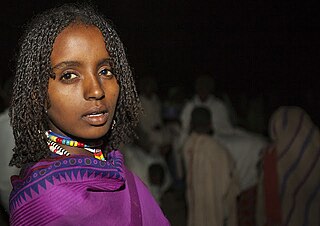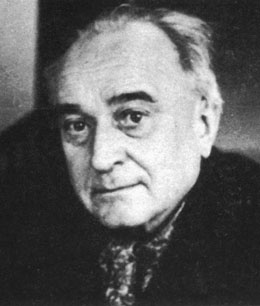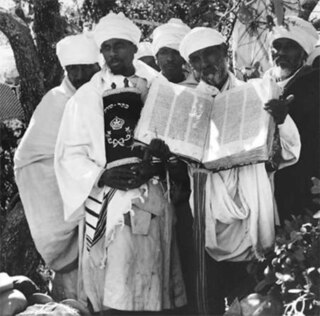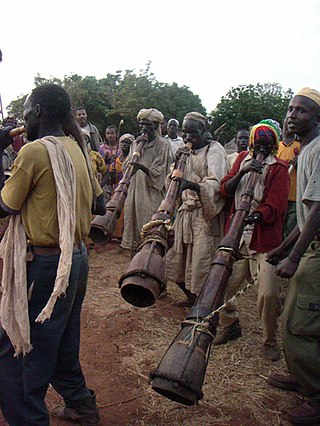Related Research Articles

The Oromo people are a Cushitic ethnic group native to the Oromia region of Ethiopia and parts of Northern Kenya. They speak the Oromo language, which is part of the Cushitic branch of the Afroasiatic language family. They are one of the largest ethnic groups in Ethiopia. According to the last Ethiopian census of 2007, the Oromo numbered 25,488,344 people or 34.5% of the Ethiopian population. Recent estimates have the Oromo comprising 45,000,000 people, or 35.8% of the total Ethiopian population estimated at 116,000,000.

Sir Edward Evan Evans-Pritchard FBA FRAI was an English anthropologist who was instrumental in the development of social anthropology. He was Professor of Social Anthropology at the University of Oxford from 1946 to 1970.

The Beta Israel, or Ethiopian Jews, are an African community of the Jewish diaspora. They coalesced in the Kingdom of Aksum and the Ethiopian Empire, which is currently divided between the Amhara Region and Tigray Region in modern-day Ethiopia. After the founding of the State of Israel in 1948, most of the Beta Israel immigrated to Israel or were evacuated from Africa through several initiatives by the Israeli government.

The Funj Sultanate, also known as Funjistan, Sultanate of Sennar or Blue Sultanate, was a monarchy in what is now Sudan, northwestern Eritrea and western Ethiopia. Founded in 1504 by the Funj people, it quickly converted to Islam, although this conversion was only nominal. Until a more orthodox form of Islam took hold in the 18th century, the state remained an "African empire with a Muslim façade". It reached its peak in the late 17th century, but declined and eventually fell apart in the 18th and 19th centuries. In 1821, the last sultan, greatly reduced in power, surrendered to the Ottoman Egyptian invasion without a fight.
Bonga is a town, woreda and one of the multicapital of the South West Ethiopia Peoples' Region in Ethiopia. Located in the Keffa Zone upon a hill in the upper Barta valley, it has a latitude and longitude of 7°16′N36°14′E with an elevation of 1,714 meters above sea level. Not confused with another town named "Bonga", near Gambela Region.
Abuk is the first woman in the myths of the Dinka people of South Sudan and the Nuer of South Sudan and Ethiopia, who call her Buk or Acol. She is the only well-known female deity of the Dinka. She is also the patron goddess of women as well as gardens. Her emblem or symbols are, a small snake, the moon and sheep. She is the mother of the god of rain and fertility (Denka). The story from her birth to marriage and child-birth is:
She was born very small, when placed in a pot, she swelled like a bean.
Abuk and her mate, called Garang, were given one corn each to eat per day, by the creator god. This happened at the time when Abuk had finished growing.
The whole of all human people would have become famished if not for the fact Abuk went to steal the food the people needed.
The rain god, called Deng, was joined to Abuk in order that there might be an abundance in the land.
A daughter (Ai-yak) and two sons were born to them.
Shanqella is an exonym for a number of Nilotic ethnic groups that lived in the westernmost part of Ethiopia, but are known to have also inhabited more northerly areas until the late nineteenth century. A pejorative, the term was traditionally used by the local Afro-Asiatic-speaking populations to refer in general terms to darker-skinned ethnic groups, particularly to those from communities speaking Nilo-Saharan languages of Western Ethiopia. These were regarded as primitive people and slave reserves by the Abyssinians.

The beliefs and practices of African people are highly diverse, including various ethnic religions. Generally, these traditions are oral rather than scriptural and are passed down from one generation to another through folk tales, songs, and festivals, and include beliefs in spirits and higher and lower gods, sometimes including a supreme being, as well as the veneration of the dead, and use of magic and traditional African medicine. Most religions can be described as animistic with various polytheistic and pantheistic aspects. The role of humanity is generally seen as one of harmonizing nature with the supernatural.
The Gumuz are an ethnic group speaking a Nilo-Saharan language inhabiting the Benishangul-Gumuz Region in western Ethiopia, as well as the Fazogli region in Sudan. They speak the Gumuz language, which belongs to the Nilo-Saharan family. The Gumuz number around 250,000 individuals.

The Toposa are a Nilotic ethnic group in South Sudan, living in the Greater Kapoeta region of Eastern Equatoria state. They have traditionally lived by herding cattle, sheep and goats, and in the past were involved in the ivory trade. They have a tradition of constant low-level warfare, usually cattle raids, against their neighbors.
Opo is an ethnic group of South Sudan and Ethiopia. They speak Opuuo, a Koman language. Most members of this ethnic group are not Muslims.
Kurmuk is a town in south-eastern Sudan near the border with Ethiopia. Kurmuk is inhabited by the Uduk and Berta peoples.
Caste systems in Africa are a form of social stratification found in numerous ethnic groups, found in over fifteen countries, particularly in the Sahel, West Africa, and North Africa. These caste systems feature endogamy, hierarchical status, inherited occupation, membership by birth, pollution concepts and restraints on commensality.

Religion in Ethiopia consists of a number of faiths. Among these mainly Abrahamic religions, the most numerous is Christianity totaling at 67.3%, followed by Islam at 31.3%. There is also a longstanding but small Ethiopian Jewish community. Some adherents of the Baháʼí Faith likewise exist in a number of urban and rural areas. Additionally, there is also a substantial population of the adherents of traditional faiths.

The Berta (Bertha) or Funj or Benishangul are an ethnic group living along the border of Sudan and Ethiopia. They speak a Nilo-Saharan language that is not related to those of their Nilo-Saharan neighbors. The total population of Ethiopian-Bertas in Ethiopia is 208,759 people. Sudanese-Bertas number around 180,000.
Uduk can refer to:

The Kwama, are a Nilo-Saharan-speaking community living in the Sudanese-Ethiopian borderland, mainly in the Mao-Komo special woreda of the Benishangul-Gumuz Region in Ethiopia. They belong, culturally and linguistically, to the Koman groups, which include neighboring communities such as the Uduk, Koma, and Opuuo. Although they traditionally occupied a larger territory, they have been forced to move to marginal, lowland areas by the Oromo from the 18th century onwards. In some villages Kwama, Oromo and Berta live together. The Kwama are often called "Mao" by other groups, especially by the Oromo. The people who live in the southern area and near the Sudanese borderland often call themselves "Gwama" and use the term "Kwama" to refer to those living further to the south and in Sudan. These other "Kwama" are usually known by anthropologists as Koma or Komo. In recent years, many people belonging to this ethnic group have been resettled by the Ethiopian state in order to provide them with clinics and schools.
Douglas Hamilton Johnson is an American scholar who lives in Britain who specializes in the history of North East Africa, Sudan and the Southern Sudan.
Wendy Rosalind James, was a British retired social anthropologist and academic. She was Professor of Social Anthropology at the University of Oxford from 1996 to 2007, and President of the Royal Anthropological Institute from 2001 to 2004.
Cultural archive is a term associated with social anthropologist Wendy James referencing the repository of knowledge found in everyday interactions that individuals reference to validate their existence in the world. This term was coined during James' research of the Uduk people of Sudan in the 1990's.
References
- ↑ González-Ruibal, Alfredo (2014). An Archaeology of Resistance: Materiality and Time in an African Borderland. Rowman & Littlefield. p. 77. ISBN 978-1-4422-3091-0.
- ↑ James, Wendy (1999). The Listening Ebony: Moral Knowledge, Religion, and Power Among the Uduk of Sudan. Oxford University Press. ISBN 978-0-19-823416-6.
- James, Wendy. 1979. `Kwanim Pa: The making of the Uduk people. Clarendon Press, Oxford.
- Sudan Update